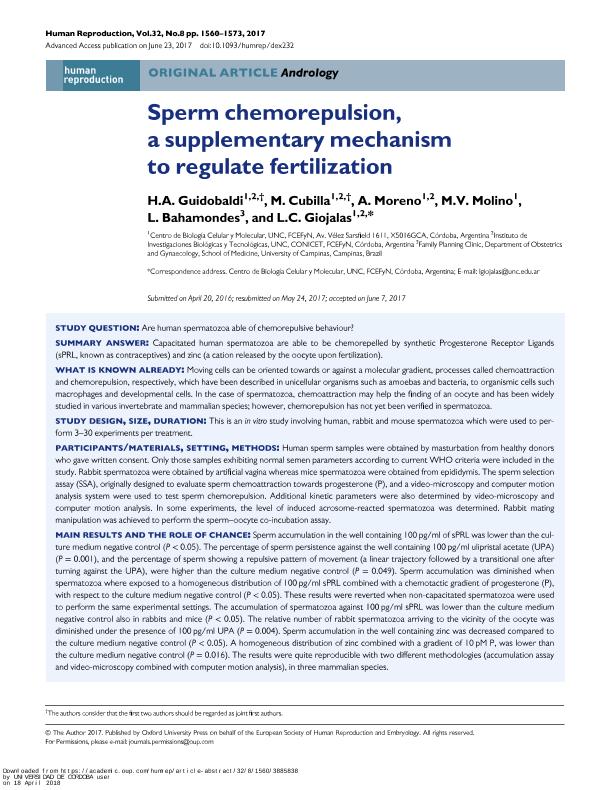Artículo
Sperm chemorepulsion, a supplementary mechanism to regulate fertilization
Guidobaldi, Héctor Alejandro ; Cubilla, Marisa Angélica
; Cubilla, Marisa Angélica ; Moreno, Ayelen
; Moreno, Ayelen ; Molino, María Victoria
; Molino, María Victoria ; Bahamondes, Luis; Giojalas, Laura Cecilia
; Bahamondes, Luis; Giojalas, Laura Cecilia
 ; Cubilla, Marisa Angélica
; Cubilla, Marisa Angélica ; Moreno, Ayelen
; Moreno, Ayelen ; Molino, María Victoria
; Molino, María Victoria ; Bahamondes, Luis; Giojalas, Laura Cecilia
; Bahamondes, Luis; Giojalas, Laura Cecilia
Fecha de publicación:
01/08/2017
Editorial:
Oxford University Press
Revista:
Human Reproduction
ISSN:
0268-1161
e-ISSN:
1460-2350
Idioma:
Inglés
Tipo de recurso:
Artículo publicado
Clasificación temática:
Resumen
Study question. Are human spermatozoa able of chemorepulsive behavior? Summary answer. Capacitated human spermatozoa are able to be chemorepelled by synthetic Progesterone Receptor Ligands (sPRL, known as contraceptives) and zinc (a cation released by the oocyte upon fertilization).What is known already. Moving cells can be oriented towards or against a molecular gradient, processes called chemoattraction and chemorepulsion, respectively, which have been described in unicellular organisms such as amoebas and bacteria, to organismic cells such macrophages and developmental cells. In the case of spermatozoa, chemoattraction may help the finding of an oocyte and has been widely studied in various invertebrate and mammalian species; however, chemorepulsion has not yet been verified in spermatozoa. Study design, size, duration. This is an in vitro study involving human, rabbit and mouse spermatozoa which were used to perform 3 to 30 experiments per treatment. Participants/materials, setting, methods. Human sperm samples were obtained by masturbation from healthy donors who gave written consent. Only those samples exhibiting normal semen parameters according to current WHO criteria were included in the study. Rabbit spermatozoa were obtained by artificial vagina whereas mice spermatozoa were obtained from epididymis. The Sperm Selection Assay (SSA), originally designed to evaluate sperm chemoattraction towards progesterone (P), and a video-microscopy and computer motion analysis system were used to test sperm chemorepulsion. Additional kinetic parameters were also determined by video-microscopy and computer motion analysis. In some experiments, the level of induced acrosome-reacted spermatozoa was determined. Rabbit mating manipulation was achieved to perform the sperm - oocyte co-incubation assay. Main results and the role of chance. Sperm accumulation in the well containing 100 pg/ml of synthetic Progesterone Receptor Ligands (sPRL) was lower than the culture medium negative control (p<0.05). The percentage of sperm persistence against the well containing 100 pg/ml ulipristal acetate (UPA) (p=0.001), and the percentage of sperm showing a repulsive pattern of movement (a linear trajectory followed by a transitional one after turning against the UPA), were higher than the culture medium negative control (p=0.049). Sperm accumulation was diminished when spermatozoa where exposed to a homogeneous distribution of 100 pg/ml sPRL combined with a chemotactic gradient of progesterone (P), with respect to the culture medium negative control (p<0.05). These results were reverted when non-capacitated spermatozoa were used to perform the same experimental settings. The accumulation of spermatozoa against 100 pg/ml sPRL was lower than the culture medium negative control also in rabbits and mice (p<0.05). The relative number of rabbit spermatozoa arriving to the vicinity of the oocyte was diminished under the presence of 100 pg/ml UPA (p=0.004). Sperm accumulation in the well containing zinc was decreased compared to the culture medium negative control (p<0.05). A homogeneous distribution of zinc combined with a gradient of 10 pM P, was lower than the culture medium negative control (p=0.016). The results were quite reproducible with two different methodologies (accumulation assay and video-microscopy combined with computer motion analysis), in three mammalian species. Limitations, reasons for caution. The experiments were performed in vitro. Even though a quite complete characterization of sperm chemorepulsion was provided, the molecular mechanism that governs sperm repulsion is currently under investigation. Wider implications of the findings. Since the chemorepelled spermatozoa are those physiologically ready to fertilise the oocyte, these findings may have both biological and clinical implications, preventing either polyspermy under natural conditions or fertilisation under pharmacological treatment with sPRL.
Archivos asociados
Licencia
Identificadores
Colecciones
Articulos(IIBYT)
Articulos de INSTITUTO DE INVESTIGACIONES BIOLOGICAS Y TECNOLOGICAS
Articulos de INSTITUTO DE INVESTIGACIONES BIOLOGICAS Y TECNOLOGICAS
Citación
Guidobaldi, Héctor Alejandro; Cubilla, Marisa Angélica; Moreno, Ayelen; Molino, María Victoria; Bahamondes, Luis; et al.; Sperm chemorepulsion, a supplementary mechanism to regulate fertilization; Oxford University Press; Human Reproduction; 32; 8; 1-8-2017; 1560–1573
Compartir
Altmétricas



